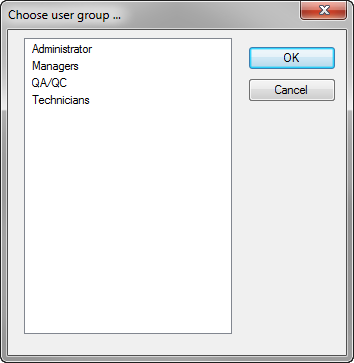Mit der Standard- oder Advanced-Lizenz verfügbar.
Mit der Workflow Manager-Lizenz verfügbar.
Users are key to controlling what functionality is available and how things are carried out by each user as an individual. Users are registered with ArcGIS Workflow Manager for Desktop and associated with a specific Windows login so they can be authenticated automatically. They are used for the following:
- Allowing/Denying access to the application
- Retrieving database connection information
- Controlling access to specific application functionality
- User-stamping history
- Assigning work to individuals
You can associate multiple groups with each user. This allows you to associate privileges (that are assigned to groups) with users by combining groups. The following diagram shows how the model allows users to be associated with different sets of privileges by associating them with groups:

See the Privileges topic for information about the types of privileges available in the Workflow Manager system.
User store
The Workflow Manager system authenticates who can access the system through their user name. Workflow Manager supports two types of user stores for user and groups—Traditional and Portal.
In the Traditional user store, users and groups are defined in the Workflow Manager Administrator and a user's user name is the Windows login. User and group roles can be imported from the Active Directory as well when using the Traditional user store.
In the Portal user store, users belong to a Portal for ArcGIS or ArcGIS Online organization, and a user's user name is as defined in the portal. Users are managed in the portal, user profiles cannot be edited, and users cannot be added or imported from the Active Directory in the Workflow Manager Administrator. Users are assigned to groups in the Workflow Manager Administrator and inherit privileges based on the Workflow Manager groups. When the user store is set to Portal user store and a query or report using the JTX_USERS table is run, any existing users defined for the Traditional user store are cleared from the database. Afterward, if the user store is switched to Traditional user store from Portal user store, the users must be created manually or imported from Active Directory. If the users are updated in Portal for ArcGIS, it is required to reconnect to the database and run a query or report to refresh the user information in the database.
Working with users
When the Traditional user store is used, users can be added and their user profiles can be edited from the Workflow Manager Administrator. When the Portal user store is used, user profiles cannot be edited; however, a user can be added to groups on the User Properties dialog box.
- Open the Administrator and connect to your Workflow Manager database.
- In the Workflow Manager Administrator, browse to the Users folder under Security.
The Users list shows all the currently configured users. If no users are configured, the list is blank.
- To add or edit a user, perform one of the following:
Add a user to the store
Right-click the Users folder and click Add.
Edit an existing user profile
Right-click an existing user and click Edit.
The User Properties dialog box appears.
- Provide the required information (denoted with an asterisk [*]) and any additional information you want to input.

Editing user profile - Click the Groups tab.
- To add one or more groups, click Add.
- Choose the groups you want to add to the user profile from the list shown.

Users are linked to application privileges through the groups they belong to. - Add users to the Administrator group to grant them the AdministratorAccess privilege.
This is an added level of protection to your database, ensuring that only users with this privilege can access the database from the Workflow Manager Administrator. All your Workflow Manager users can still access the repository from the client application to manage and execute their jobs.